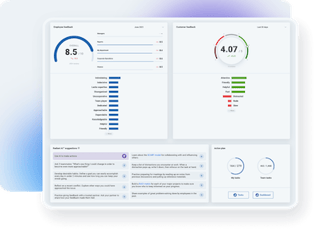
10 Key Drivers of Employee Engagement: Evolving Strategies for a Modern Workforce
Employee engagement represents a foundational element of any organization’s success and can be especially valuable in tough economic times. Concentrating on employee engagement can help businesses weather tough economic times better and may even enable them to thrive while their competition falters.
There’s just one problem. Fully engaged workforces have become an anomaly in the current work environment. In fact, Gallup reports that workplace engagement among U.S. workers hit an 11-year low in Q1 of 2024.
How can your organization nurture trust in leadership and get employees engaged through meaningful work? Here’s a look at 10 engagement drivers that you can’t afford to ignore.
1. Trust in Leaders: A Cornerstone of Employee Engagement
Most people trust their bosses, right? Unfortunately not. Only about 21% of employees trust their direct managers. These statistics are indicative of a major employee satisfaction problem that can erode employee engagement and make cultivating feelings of loyalty in the workforce all but impossible.
There are multiple reasons why people don’t seem to trust their bosses. The rise in remote and hybrid work has made building and maintaining trust more challenging. Think about it. You simply don’t have a chance to interact with employees in a face-to-face setting, which may make it tough to build relationships and cultivate trust.
To build trust, business leaders need emotional intelligence — skills like empathy, self-awareness, and relationship management. Business leaders must also embody company values and lead by example. Leaders have to follow through on their commitments and put team members in a position to succeed. 
Additionally, organizational leaders must address unconscious biases and demonstrate fairness in decision-making. Transparent communication practices can keep employees informed and let them know that the organization intends to treat them right, which can improve employee retention.
Using AI-driven feedback tools like Macorva helps provide continuous insights into leadership effectiveness. By evaluating diverse feedback sources and detecting bias, Macorva ensures fair assessments and strengthens trust. Its seamless integration with existing HR systems makes accessing up-to-date data straightforward, allowing leaders to act on feedback promptly and transparently.
How to measure trust in leadership
Measuring trust in leadership can be accomplished through various methods that provide insights into employee perceptions of their leaders. Some ways to measure trust in leadership include:
- Employee Surveys: Conduct regular surveys asking employees to rate their level of trust in leadership and provide feedback on specific actions or behaviors that contribute to trust or distrust
- Focus Groups: Organize small groups of employees to discuss their experiences with leadership and identify areas where trust can be strengthened or improved
- Exit Interviews: Gather feedback from employees who are leaving the organization, asking for their honest assessment of trust in leadership and any suggestions for improvement
- Pulse Surveys: Send out short, frequent surveys to gauge employee satisfaction and feelings of trust in leadership over time
By regularly measuring trust in leadership, organizations can identify areas for improvement and implement strategies to strengthen trust and support better workplace engagement.
2. Coworker Relationships: The Fuel of Employee Engagement
Coworker relationships have a big impact on how people feel about their jobs. In fact, 69.5% of employees state that they would be happier at work if they had stronger connections with their colleagues. However, these relationships need to form organically. You can’t force your team members to be friends.
You can proactively create opportunities for collaboration and connection, even in hybrid and remote work environments. If your employees work from the office, consider hosting luncheons and giving team members a chance to socialize.
If you use a remote or hybrid work model, consider virtual team-building exercises like games, trivia, and projects.
You’ll also need to make cross-departmental initiatives a priority. Encourage team members to collaborate with other departments so they can build new relationships and pool their collective talents for the good of the organization. For example, you could promote cross-departmental projects between marketing and sales.
Promoting diversity, equity, and inclusion (DEI) initiatives is another important aspect of team-building. Perhaps most importantly, you need to create a culture of shared experiences, such as celebrating milestones (i.e., anniversaries with the company or birthdays).
The role of community in workplace satisfaction
Having good relationships with coworkers lets you bond over shared experiences, seek advice, and brainstorm ideas. Feeling a part of a team with mutual respect can make you more positive about work and motivate you to give your best effort. Recognizing the importance of community and positive work relationships is key to having a happy, productive, and engaged workforce and boost employee retention.
By enabling easy feedback sharing and interaction, Macorva helps ensure all voices are heard, fostering inclusivity and naturally strengthening coworker relationships. With features like 360-degree feedback and AI-powered insights, Macorva can help you:
- Identify and address issues that might be hindering positive relationships.
- Recognize employees who contribute to a positive and collaborative work environment.
- Promote a culture of appreciation and belonging.
With these insights and tailored action plans, you can create a workplace where employees feel connected and motivated to build strong relationships with their colleagues.

3. Learning and Development Opportunities: The Growth Engine of Employee Engagement
Learning and development opportunities are major engagement drivers that you need to be leveraging. You need to provide employees with tools to upskill and grow, especially in this era of rapid technological change.
Don’t rely on generic learning programs. Leverage AI-powered performance management tools to identify where each team member excels and where they struggle. These insights help create personalized learning pathways that promote engagement and growth. Enhance these pathways by incorporating technologies like virtual reality (VR), making them more immersive and effective for remote and hybrid workers.
However, they aren’t a replacement for tried-and-true development strategies, such as mentorship. A great mentorship program gives seasoned veterans an opportunity to share their wisdom with newer employees.
You can also add a modern twist to your mentorship initiative through reverse mentoring, where junior employees share their insights with senior leaders.
You’ll also need to tap into the power of hands-on experience. Stretch assignments, which are outside of a person’s normal scope, can get people out of their comfort zone and help you fill skill gaps. Just make sure to set them up for success by pairing them with more experienced employees.
Tailoring learning opportunities to individual needs
To maximize the impact of learning and development opportunities on employee engagement, it’s essential to tailor these opportunities to individual needs and preferences. Some ways to achieve this include:
- Personalized learning plans: Harvard Business Review recommends developing customized learning plans for each employee, taking into consideration their unique strengths, weaknesses, and career aspirations.
- Mentorship programs: Pair employees with mentors who can provide guidance and support tailored to their specific needs and goals.
- Flexible learning formats: Offer a variety of learning formats, such as online courses, in-person workshops, and self-paced learning resources, to accommodate different learning preferences and styles.
- Employee input: Encourage employees to provide feedback on their learning and development needs and preferences and use this information to inform the design and delivery of learning opportunities.
Incorporating platforms like Macorva can enhance these efforts by providing detailed analytics on employee performance and potential growth areas. With 360-degree and real-time feedback capabilities, managers can effectively create tailored development plans aligned with individual career goals, ensuring that learning opportunities are both relevant and impactful. This approach not only supports individual advancement but also aligns employee growth with organizational objectives.

Impact of upskilling on employee retention
According to McKinsey, investing in employee upskilling can greatly improve employee retention. When employees see that their company is dedicated to their growth and development, they tend to be happier with their jobs and less likely to look for opportunities elsewhere. A few ways upskilling can help retain employees include:
- Increased job satisfaction: Employees who have the opportunity to learn and grow in their roles are more likely to feel challenged, motivated, and satisfied with their work.
- Greater loyalty: Employees who feel supported and valued by their organization are more likely to develop a strong sense of loyalty and commitment to the company.
- Enhanced career opportunities: Upskilling can open up new career paths and opportunities for advancement within the organization, making employees more likely to see a long-term future with the company.
- Competitive advantage: Organizations that invest in employee upskilling can attract and retain top talent, giving them a competitive advantage in the marketplace.
By prioritizing employee upskilling, organizations can not only improve employee engagement but also enhance retention and overall business success.
4. Company Values: The Heartbeat of Employee Engagement
Your company’s values will have a direct impact on employee engagement and retention. It will also influence your ability to attract top talent. A survey conducted among European workers revealed that 59% of people will not work for a business that does not share their values. 55% of respondents said a pay increase wouldn’t change their minds.
The bottom line is that you need to align your company’s values with social and environmental responsibilities that matter to today’s workforce. Doing so can enhance trust, loyalty, and morale while helping you attract top talent.
Simply claiming certain values is not enough. They must be embedded in your decision-making processes, performance metrics, and daily operations. For example, integrating sustainability goals into project planning or tying bonuses to ethical behavior reinforces a values-driven culture.
Communicating company values authentically is essential. Your leadership team can highlight these values in meetings, emails, marketing materials, and everyday interactions with employees. You should regularly measure and report value alignment — through employee surveys or customer feedback — to demonstrate accountability and reinforce trust.
Communicating company values effectively
Company values should really come alive for employees to feel inspired. If the mission and values are unknown or misunderstood, they're just words. Employees can get excited about company values they understand and can apply in their daily work. When employees align their behavior with these values, they'll be more engaged, seeing their hard work lead to great performance. Some ways to establish and communicate company values that resonate with employees include:
- Reinforcing values: Repeat company values in writing and in meetings, making them a central part of the organizational culture.
- Incorporating values into metrics: Ensure that company values are integrated into performance evaluations and goal-setting processes.
- Modeling values: Ensure company leaders are demonstrating their commitment to company values and setting an example for others to follow.
5. Feedback Channels: The Pulse of Employee Engagement
Your employees want to be listened to, and they may quit if they feel you aren’t applying their feedback. Researchers found that 41% of employees have quit a job because they weren’t being listened to.
Feedback channels are the lifeblood of engagement, offering real-time insights into employee needs and concerns. AI-powered systems analyze patterns and trends to provide actionable insights, while surveys gauge worker sentiments through both anonymous and direct feedback. Balancing anonymity with accountability encourages honesty and promotes open communication about potential concerns.
Closing the feedback loop is vital for making employees feel valued. Share tangible results from their input and communicate the actions you’re taking to improve workplace culture. If certain concerns can't be addressed due to constraints, be transparent about those limitations as well.
Encouraging feedback: Building an open communication culture
There are many ways to encourage direct feedback throughout the organization, including:
- Recognition mechanisms: Enable peer-to-peer and manager-direct report shout-outs, acknowledging outstanding work and contributions.
- Anonymous rating platforms: Allow employees to give and receive 360-degree feedback, helping to identify areas for improvement and growth.
- Two-way feedback opportunities: Create forums or town hall meetings that enable employees to provide feedback to senior management, fostering a culture of open communication and collaboration.
When looking to enhance these channels, consider solutions that offer AI-powered surveys and real-time feedback. These tools allow for continuous input, ensuring employees feel heard and valued. Macorva EX offers dynamic feedback collection through its intuitive interface that encourages participation by making it easy for employees to share their thoughts anonymously or openly. Backed by Radiant AI, feedback is transformed into actionable insights, enabling managers to quickly address concerns and implement improvements that help strengthen open communication and continuous growth. This streamlined feedback process helps organizations maintain high levels of engagement and satisfaction.

Effectively implementing feedback systems.
Implementing effective feedback systems requires a thoughtful and strategic approach to ensure that feedback is collected, analyzed, and acted upon in a way that promotes employee engagement and drives organizational improvement. A report from IBM highlights the need for companies to be responsive to feedback in order to improve engagement. Some best practices for implementing feedback systems include:
- Select the right tools: Choose feedback tools and platforms that are user-friendly, accessible, and provide the functionality needed to collect meaningful feedback in a timely and efficient manner.
- Communicate the purpose: Clearly communicate the purpose of the feedback system to employees, emphasizing the importance of honest and constructive feedback for driving organizational growth and improvement.
- Analyze and act on feedback: Regularly analyze feedback data to identify trends, areas for improvement, and opportunities for change. Communicate the findings to employees and involve them in the process of developing and implementing action plans to address identified issues.
When selecting a feedback platform, it's also crucial to consider how well it integrates with your existing systems and daily workflows. Macorva offers seamless integration with HR systems and communication tools like Slack and Teams, ensuring that feedback fits naturally into employees' routines. Its intuitive design makes it easy for employees to engage with the platform, while advanced analytics quickly turn feedback into actionable insights. This integration helps teams respond effectively to feedback, improving engagement and aligning efforts with business goals.
6. Work-Life Integration: The New Balance
Work-life integration represents the modern perspective toward a work-life balance. In the past, proponents of work-life balance tended to favor a rigid separation of business and personal matters. The integrated approach emphasizes a seamless coexistence.
Think about it this way. You want your employees to be able to unwind and leave work at work, but it's also important for their coworker friendships and job responsibilities to add value to their personal lives.
Flexible work arrangements are a great tool for empowering employees to address their personal needs while also being productive. When employees have the freedom to manage their time effectively, they feel trusted and supported. This can translate to better productivity and loyalty.
You also need to prevent burnout. According to the Society for Human Resource Management (SHRM), 44% of employees feel burned out, 30% often feel stressed, and 22% often feel anxious.
There are multiple ways to combat burnout. Introduce initiatives like fitness challenges, mindfulness programs, and mental health days to encourage your staff to step away and recharge. Encourage team members to be open about work-related stress and create a culture where taking breaks is normalized.
Technology plays a crucial role in enabling work-life integration. Collaboration tools make work more accessible. However, you don’t want to create an always-on culture that makes people feel like they must constantly be connected to work. Set clear expectations for after-hours communication to ensure employees can disconnect.
7. Purpose and Meaningful Work: The Engagement Catalyst
People want to feel a sense of purpose at work. If you can cultivate these feelings for your employees, they will be a lot more motivated and engaged. Some roles have an obvious connection to the company’s mission.
For instance, the marketing team will know that their work on a campaign to launch a new product has a direct impact on the company’s success. However, people in support roles may not experience this same sense of purpose.
Macorva's AI-powered employee scorecards enhance this communication by directly connecting feedback to individual employees. These scorecards provide personalized insights that highlight how each person's contributions align with organizational objectives, reinforcing their sense of purpose and impact within the company.
It’s up to you to clearly communicate how each person’s efforts contribute to the company’s goals and mission. Department or team-level updates are the most effective way to achieve this, as you want to tailor your messaging based on each group’s involvement and responsibility.
In addition, consider how the company is positively impacting the community and fulfilling its social responsibility. For example, if your organization supports the local community through fundraising or clean-up efforts, ensure employees know how their work contributes to these efforts.
If your employees volunteer to help with neighborhood outreach, share photos and videos to spotlight their selfless behavior. Highlighting these contributions not only boosts morale but also strengthens employees' connection to the company's values and mission.
Job crafting represents another way to make work more meaningful. This is where employees customize their jobs to align with their strengths and interests. Encourage employees to take ownership of their roles and delegate responsibilities across a team to help everyone leverage their strengths.
Lastly, you need to consider that different generations may define “meaningful work” differently.
In a recent study, Deloitte surveyed Gen Z and millennial workers to gauge what areas of their organizations they can have the greatest influence on. Top answers include products and services, areas related to DEI, and areas related to personal development. Workers in these generations may find the most value in assignments related to these goals.
8. Technology and Employee Engagement
Technology has changed how you engage with your organization, especially in hybrid and remote work environments.
Cloud-based HR tools streamline processes like onboarding, performance tracking, and feedback collection. These tools provide employees with easy access to resources, making your experience seamless and enhancing workplace satisfaction.
AI and machine learning take engagement to the next level by enabling you to personalize how you communicate with employees and measure their performance. For example, AI-powered surveys can gauge employee sentiment and reveal trends that will help you boost engagement. ML algorithms can predict turnover risk and empower your HR team to proactively foster retention.
Remote and hybrid teams reap the most benefits from technology. Modern tools like VIR can simulate collaborative environments for team-building activities. Video conferencing and project management tools ensure smooth workflows.
While technology supports engagement, you must make human interaction the center of your engagement efforts. By integrating advanced technologies to enhance personal connections, you can create a more engaging workplace.
Platforms like Macorva enhance this by integrating seamlessly with existing processes, ensuring technology complements personal connections. This approach helps maintain strong relationships and recognizes contributions without disrupting workflows.
10. Diversity, Equity, and Inclusion (DEI) Initiatives
DEI programs can make employees from all backgrounds feel a sense of belonging. Celebrating individual differences can also facilitate better collaboration and innovation.
Most employees want the companies they work for to pay attention and invest in DEI initiatives. However, just 54% believe that their employers are paying the right amount of attention to these issues.
To create an inclusive work environment, you need to focus on equitable hiring practices, transparent pay structures, and accessible career development opportunities. As a business leader, you play a key role in promoting respect through training on unconscious biases and inclusive communication.
However, you need to approach DEI with nuance. Be respectful to all employees and ensure your DEI initiatives are integrated into your company’s core values. DEI should never overshadow the organization’s mission, but instead needs to be an intrinsic part of daily work life.
How do you know if your initiatives are working? Engagement surveys and retention metrics provide important pieces of the puzzle. Both anonymous and open feedback channels can help you build trust among employees and strike the right balance with your diversity and equity program.
 10. Employee Well-Being and Mental Health
10. Employee Well-Being and Mental Health
According to the American Psychological Association, 92% of workers say that it's “very” or “somewhat” important to work at a place that values their psychological and emotional well-being. When you support the mental and physical health needs of your team members, you can help them thrive at home and at work.
Investing in wellness programs shows that you care. Initiatives like access to mental health resources and gym memberships go a long way in addressing holistic well-being. These programs can help workers manage stress and maintain energy levels.
Open conversations about mental health can reduce stigma and create a supportive environment. You and the leadership team should model vulnerability and acknowledge challenges to encourage others to seek help when needed. If possible, offer mental health days or flexible scheduling to reinforce your commitment to employee well-being.
There’s a strong link between productivity, health, and well-being. If your workers are in good emotional, mental, and physical health, they will be more productive than those who are not.
Key Takeaways
Employee engagement is influenced by various controllable factors. When employees can connect with the company vision, their colleagues, and leaders, they tend to develop a stronger emotional bond with the organization and their work, leading to higher engagement and improved performance. Also, giving and receiving anonymous feedback, like through pulse surveys, encourages employees to share their true work experiences, ultimately sparking new enthusiasm for their work. When these engagement drivers work together, the outcome is a more energized workforce that's better equipped to achieve organizational goals and drive success.
Explore how Macorva can support your team with effective tools for connection and feedback. Find out more in the 2-minute video series: https://www.macorva.com/resources/macorva-ex-video-playlist
Editors note: this blog was originally published in April 2019 and has been updated for accuracy and comprehensiveness.










